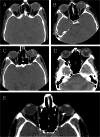Exploring computerized tomography findings and ocular trauma score in open globe injuries: assessing imaging's predictive value
- PMID: 40596913
- PMCID: PMC12220044
- DOI: 10.1186/s12886-025-04190-w
Exploring computerized tomography findings and ocular trauma score in open globe injuries: assessing imaging's predictive value
Abstract
Background: To investigate the relationship between computerized tomography (CT) findings and the Ocular Trauma Score (OTS) in patients with open globe injury (OGI).
Methods: This study included 123 individuals with OGI, examining injury characteristics, clinical symptoms, and CT scans for scleral irregularity, reduced globe volume, dislocated crystalline lens, aberrant vitreous density, chorioretinal thickening, and foreign body/air presence. The prognostic value of CT imaging in OGI was evaluated by assessing its relationship with OTS findings.
Results: The most common OTS category was stage 3, found in 71 eyes (57.7%). The prevalent CT findings included severe scleral irregularity or globe collapse (34.1%), dislocated crystalline lens (33.3%), and abnormal vitreous density (26.8%). Multivariate analysis revealed that severe scleral irregularity or globe collapse (Odds Ratio [OR] = 1.36, p = 0.006) and abnormal vitreous density (OR = 1.7, p < 0.001) were significantly associated with more advanced OTS stages (I or II), indicating more severe ocular trauma. The presence of three CT findings was associated with a higher likelihood of falling into OTS stages I or II (OR = 6.82, p = 0.001). Conversely, the absence of CT findings was associated with a decreased probability of having more severe OTS stages (OR = 0.05, p < 0.001).
Conclusions: The study concludes that imaging findings are valuable for correlating with the severity of open globe injuries, highlighting the importance of CT in assessing ocular trauma.
Keywords: Computerized tomography; Ocular trauma score; Open Globe injury.
© 2025. The Author(s).
Conflict of interest statement
Declarations. Ethics approval and consent to participate: This study was approved by the Dokuz Eylul University, School of Medicine Ethics Committee (Date: 10.01.2024, Decision No: 2024/02–17). Consent for publication: Not applicable. Competing interests: The authors declare no competing interests.
Figures

References
-
- Crowell EL, Koduri VA, Supsupin EP, Klinglesmith RE, Chuang AZ, Kim G, et al. Accuracy of computed tomography imaging criteria in the diagnosis of adult open Globe injuries by neuroradiology and ophthalmology. Acad Emerg Med. 2017;24:1072–9. 10.1111/ACEM.13249. - PubMed
-
- May DR, Kuhn FP, Morris RE, Witherspoon CD, Danis RP, Matthews GP, et al. The epidemiology of serious eye injuries from the united States eye injury registry. Graefes Arch Clin Exp Ophthalmol. 2000;238:153–7. 10.1007/PL00007884. - PubMed
-
- Al-Mezaine HS, Osman EA, Kangave D, Abu El-Asrar AM. Prognostic factors after repair of open Globe injuries. J Trauma - Injury Infect Crit Care. 2010;69:943–7. 10.1097/TA.0B013E3181C9F395. - PubMed
-
- Joseph DP, Pieramici DJ, Beauchamp NJ. Computed tomography in the diagnosis and prognosis of open-globe injuries. Ophthalmology. 2000;107:1899–906. 10.1016/S0161-6420(00)00335-3. - PubMed
MeSH terms
LinkOut - more resources
Full Text Sources
Medical

